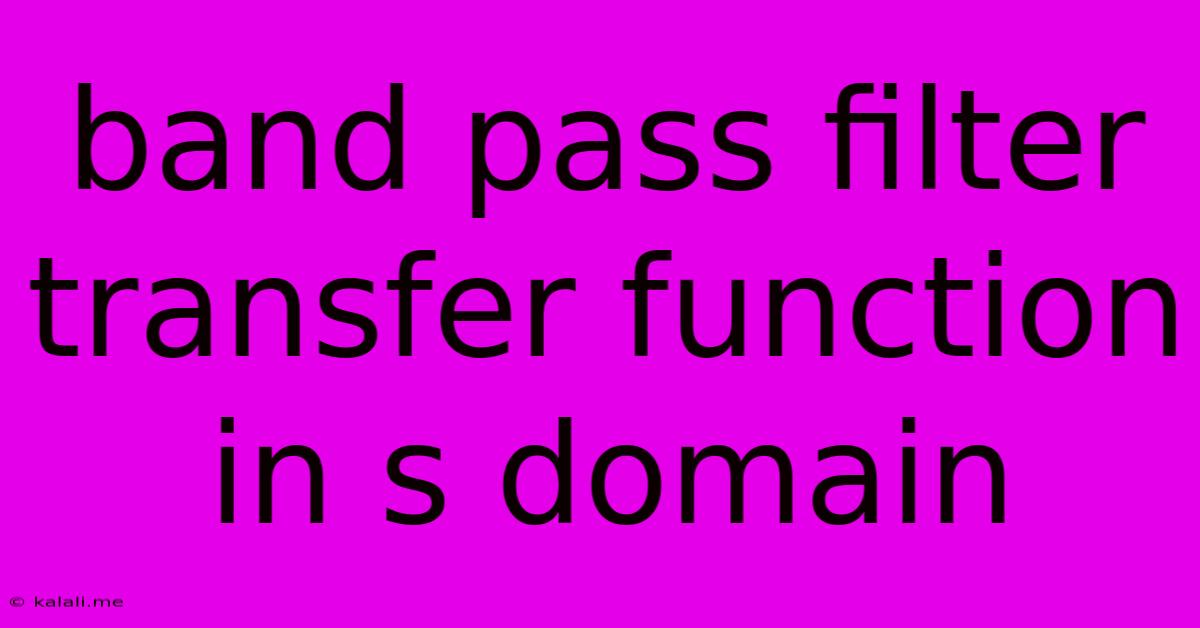Band Pass Filter Transfer Function In S Domain
Kalali
Jun 07, 2025 · 3 min read

Table of Contents
Understanding the Band-Pass Filter Transfer Function in the s-Domain
This article delves into the intricacies of the band-pass filter transfer function, specifically focusing on its representation in the s-domain (Laplace domain). We'll explore its characteristics, design considerations, and applications. Understanding this function is crucial for anyone working with signal processing, circuit design, or control systems. This explanation will be beneficial for both beginners and those seeking a deeper understanding of the topic.
A band-pass filter is a type of signal processing filter that passes frequencies within a certain range (the "passband") and attenuates frequencies outside of that range (the "stopbands"). Its transfer function, represented in the s-domain, provides a mathematical model that describes this frequency-selective behavior.
Defining the Transfer Function
The transfer function, denoted by H(s), is the ratio of the output voltage (or current) to the input voltage (or current) in the Laplace domain. For a band-pass filter, this function typically takes the form of a second-order system, although higher-order filters are also possible:
H(s) = K * (s/ω₀) / [(s/ω₀)² + (s/Qω₀) + 1]
Where:
- H(s): The transfer function in the s-domain.
- K: The gain of the filter at the center frequency. This represents the amplification or attenuation at the peak frequency response.
- ω₀: The center frequency (in radians per second) of the filter, representing the frequency at which the filter provides maximum gain. It's also known as the resonant frequency.
- Q: The quality factor. This parameter determines the sharpness of the filter's response. A higher Q value results in a narrower bandwidth and a sharper peak, while a lower Q value results in a wider bandwidth and a flatter peak. It signifies the filter's selectivity.
This is a canonical form, and other equivalent representations exist.
Understanding the Parameters
Let's break down the significance of each parameter:
-
Center Frequency (ω₀): This is the frequency at which the filter exhibits its maximum gain. It determines the central point of the passband. You often specify this in Hertz (Hz) instead of radians/second, using the relationship ω₀ = 2πf₀, where f₀ is the center frequency in Hz.
-
Quality Factor (Q): This critical parameter defines the selectivity of the filter. A higher Q implies a narrower bandwidth and a sharper peak response, meaning it will only allow a narrow range of frequencies to pass. Conversely, a lower Q leads to a wider bandwidth. The bandwidth (BW) is related to the quality factor and the center frequency by the equation: BW = ω₀/Q.
-
Gain (K): This determines the amplitude of the signal passing through the filter at the center frequency. It represents the amplification or attenuation applied to the signal within the passband.
Analyzing the Frequency Response
To analyze the filter's behavior in the frequency domain, we substitute s = jω (where j is the imaginary unit and ω is the angular frequency) into the transfer function. This converts H(s) to H(jω), which allows us to plot the magnitude and phase response as a function of frequency. This provides a visual representation of the filter's frequency selectivity.
The magnitude response will show a peak at the center frequency ω₀, dropping off at higher and lower frequencies, defining the passband and stopbands. The phase response will illustrate the phase shift introduced by the filter at different frequencies.
Practical Applications
Band-pass filters find extensive applications in various fields, including:
- Audio Processing: Isolating specific frequency ranges in music or speech.
- Communication Systems: Selecting a specific channel in radio or wireless communication.
- Medical Imaging: Enhancing specific frequency components in medical signals.
- Control Systems: Filtering out unwanted noise and isolating specific frequency ranges in feedback control loops.
Conclusion
The s-domain transfer function provides a powerful tool for designing and analyzing band-pass filters. Understanding the parameters – center frequency, quality factor, and gain – is essential for controlling the filter's characteristics and tailoring its performance to specific applications. By manipulating these parameters, engineers can achieve the desired frequency response, creating filters that efficiently isolate or eliminate certain frequencies within a signal. This fundamental understanding allows for the design of filters suited to various signal processing needs.
Latest Posts
Latest Posts
-
12 Gauge Wire For Pool Pump
Jun 07, 2025
-
Ansible Core Requires A Minimum Of Python2
Jun 07, 2025
-
Can You Do Me A Solid
Jun 07, 2025
-
Fig Tree In The Bible Symbolism
Jun 07, 2025
-
Can You Stream Movies On Work Computer
Jun 07, 2025
Related Post
Thank you for visiting our website which covers about Band Pass Filter Transfer Function In S Domain . We hope the information provided has been useful to you. Feel free to contact us if you have any questions or need further assistance. See you next time and don't miss to bookmark.